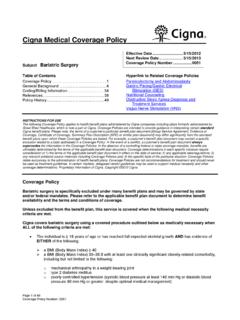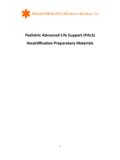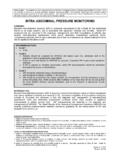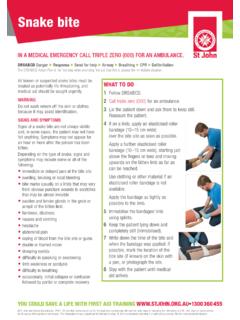Transcription of Polysomnography and Portable Monitoring for Sleep …
1 MEDICAL POLICY. Polysomnography AND Portable . Monitoring FOR EVALUATION OF Sleep . RELATED BREATHING DISORDERS. Policy Number: 2014T0334P. Effective Date: April 1, 2014. Table of Contents Page Related Medical Policies: BENEFIT CONSIDERATIONS 1 Obstructive Sleep COVERAGE 2 Apnea Treatment DEFINITIONS . 5. APPLICABLE 8. DESCRIPTION OF 9. CLINICAL 11. FOOD AND DRUG 20. CENTER FOR MEDICARE AND MEDICAID. SERVICES . 22. 22. POLICY HISTORY/REVISION 27. Policy History Revision Information INSTRUCTIONS FOR USE. This Medical Policy provides assistance in interpreting UnitedHealthcare benefit plans. When deciding coverage, the enrollee specific document must be referenced. The terms of an enrollee's document ( , Certificate of Coverage (COC) or Summary Plan Description (SPD).)
2 And Medicaid state contracts)) may differ greatly from the standard benefit plans upon which this medical policy is based. In the event of a conflict, the enrollee's specific benefit document supersedes this Medical Policy. All reviewers must first identify enrollee eligibility, any federal or state regulatory requirements and the enrollee-specific plan benefit coverage prior to use of this Medical Policy. Other Policies and Coverage Determination Guidelines may apply. UnitedHealthcare reserves the right, in its sole discretion, to modify its Policies and Guidelines as necessary. This Medical Policy is provided for informational purposes. It does not constitute medical advice. UnitedHealthcare may also use tools developed by third parties, such as the MCG Care Guidelines, to assist us in administering health benefits.
3 The MCG Care Guidelines are intended to be used in connection with the independent professional medical judgment of a qualified health care provider and do not constitute the practice of medicine or medical advice. BENEFIT CONSIDERATIONS. Plan Document Language Before using this guideline, please check enrollee's specific plan document and any federal or state mandates, if applicable. Polysomnography and Portable Monitoring for Sleep Related Breathing Disorders: Medical Policy (Effective 04/01/2014). 1. Proprietary Information of UnitedHealthcare. Copyright 2014 United HealthCare Services, Inc. Indications for Coverage 1. Medical or surgical treatment of snoring is covered only if that treatment is determined to be part of a proven treatment for documented obstructive Sleep apnea.
4 Refer to the applicable medical policy to determine if the treatment proposed is proven for obstructive Sleep apnea. 2. Oral appliances for snoring with a diagnosis of obstructive Sleep apnea are addressed in the Durable Medical Equipment, Orthotics, Ostomy Supplies, Medical Supplies and Repairs/Replacements Coverage Determination Guideline Coverage Limitations and Exclusions 1. Medical and surgical treatment of snoring is excluded except as described in #1 above. 2. Medically prescribed treatment for snoring (without a diagnosis of obstructive Sleep apnea) that includes a Bi-Level or CPAP equipment identified via a clinical review is not a Covered Health Service. 3. Surgical treatments for snoring without a diagnosis of obstructive Sleep apnea are not a Covered Health Service.
5 Examples include, but are not limited to: Uvulopalatopharyngoplasty (UPPP). Laser-assisted uvulopalatoplasty (LAUP). Somnoplasty Submucosal radiofrequency tissue volume reduction For ASO plans with SPD language other than fully-insured Generic COC language Please refer to the enrollee's plan specific SPD for coverage. COVERAGE RATIONALE. Attended Full-Channel Nocturnal Polysomnography (NPSG)/Laboratory Sleep Test (LST) (CPT codes 95808, 95810, 95811). I. Attended full-channel nocturnal Polysomnography (NPSG)/laboratory Sleep test (LST), performed in a healthcare facility is proven and medically necessary in patients not previously diagnosed with OSA with one (1) or more of the following indications: A. one (1) or more of the following co-morbid conditions that would degrade the accuracy of Portable Monitoring with a home Sleep test (HST): 1.
6 Significant chronic pulmonary disease as defined by a forced expiratory volume (FEV1 % pred) of < 60 (Pelligrino, 2005). 2. neuromuscular disease/neurodegenerative disorder [examples include but are not limited to, Parkinson's disease, myotonic dystrophy, amyotrophic lateral sclerosis, multiple sclerosis with associated pulmonary disease]. 3. significant cardiac disease [examples include but are not limited to, congestive heart failure (NYHA class III or IV), uncontrolled significant persistent cardiac arrhythmia, pulmonary hypertension, history of prior stroke]. 4. body mass index (BMI) 50 (DeMaria 2007, Blackstone 2009). 5. Obesity Hypoventilation Syndrome (OHS); OR. Polysomnography and Portable Monitoring for Sleep Related Breathing Disorders: Medical Policy (Effective 04/01/2014).
7 2. Proprietary Information of UnitedHealthcare. Copyright 2014 United HealthCare Services, Inc. B. one (1) or more of the following complex Sleep disorders: 1. periodic limb movement disorder (PLMD). 2. parasomnia with disruptive, violent or potentially injurious Sleep behavior suspicious of rapid eye movement (REM) (RBD) disorder 3. narcolepsy once other causes of excessive sleepiness have been ruled out 4. history of central Sleep apnea; OR. C. patient is a child or adolescent ( 20 years of age); OR. D. results of previous HST were either 1. indeterminate for suspected OSA or upper airway resistance syndrome; or 2. technically inadequate after 2-3 nights; OR. E. patient lacks the mobility or dexterity to use HST equipment safely at home; OR.
8 F. cognitive impairment such that patient is unable to perform a home Sleep study II. Attended full-channel nocturnal Polysomnography (NPSG)/laboratory Sleep test (LST), performed in a healthcare facility is proven and medically necessary in patients previously diagnosed with OSA with one (1) or more of the following indications: A. evaluation for the presence of obstructive Sleep apnea in patients before undergoing upper airway surgery for snoring or obstructive Sleep apnea; OR. B. assessment of treatment results under the following conditions: 1. the discontinuation of CPAP, Bi-Level, or oral appliance after surgery; or 2. resolution of OSA after surgical treatment for OSA; or 3. resolution of OSA following significant weight loss such as that associated with bariatric surgery; OR.
9 C. significant cardiac disease [examples include but are not limited to, congestive heart failure (NYHA class III or IV), uncontrolled significant persistent cardiac arrhythmia, pulmonary hypertension, history of prior stroke]. Unattended Full-Channel or Limited Channel Portable Monitoring /Home Sleep Test (HST). (CPT codes 95800, 95801, 95806 and HCPCS codes G0398, G0399, G0400). III. Unattended full-channel or limited channel Portable Monitoring /home Sleep testing (HST), performed out of center as a single night test is proven and medically necessary in patients not previously diagnosed with OSA when such testing meets ALL of the following criteria: A. devices must meet the minimum requirement for limited channel testing measuring heart rate, oxygen saturation, and respiratory analysis; AND.
10 B. patient is an adult (>20 years of age) ; AND. C. no suspicion of complex Sleep disorders [examples include, but are not limited to narcolepsy(once other causes of excessive sleepiness have been have been ruled out), parasomnia with disruptive, violent or potentially injurious Sleep behavior suspicious of REM (RBD) disorder, history of central Sleep apnea, periodic limb movement disorder]; AND. D. no co-morbid conditions that could impact the accuracy of the study (examples include but are not limited to significant chronic pulmonary disease, neuromuscular disease/neurodegenerative disorder, significant cardiac disease); AND. Polysomnography and Portable Monitoring for Sleep Related Breathing Disorders: Medical Policy (Effective 04/01/2014).




